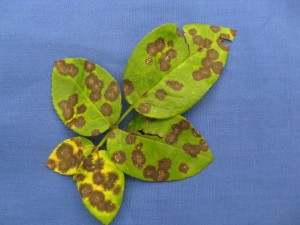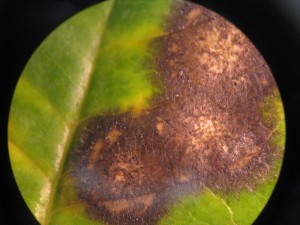Hey, what are those black spots on those roses?
You might have guessed, it’s “black spot.”
Here is some great information from Ward Upham:
Blackspot of Roses
A common disease of roses is blackspot, a fungus disease that can cause defoliation of susceptible plants. Look for dark, circular lesions with feathery edges on the top surface of the leaves and raised purple spots on young canes. Infected leaves will often yellow between spots and eventually drop.
The infection usually starts on the lower leaves and works its way up the plant. Blackspot is most severe under conditions of high relative humidity (>85%), warm temperatures (75 to 85 degrees F) and six or more hours of leaf wetness. Newly expanding leaves are most vulnerable to infection. The fungus can survive on fallen leaves or canes and is disseminated primarily by splashing water.
Cultural practices are the first line of defense.
1. Don’t plant susceptible roses unless you are willing to use fungicide sprays. For a list
of blackspot resistant varieties, go to: http://www.ppdl.purdue.edu/ppdl/weeklypics/3-22-04.html
2. Keep irrigation water off the foliage. Drip irrigation works well with roses.
3. Plant roses in sun in areas with good air movement to limit the amount of time the
foliage is wet.
4. Remove diseased leaves that have fallen and prune out infected rose canes to minimize inoculum.
If needed, protect foliage with a regular spray program (10- to 14-day schedule) ) of effective fungicides. Recommended fungicides include tebuconazole (Bayer Disease Control for Roses,Flowers and Shrubs), myclobutanil (Immunox, Immunox Plus), triticonazole (Ortho Rose & Flower Disease Control) and chlorothalonil (Broad Spectrum Fungicide, Garden Disease Control, others).
Here is a closer zoom of some of the spots.
If you really look closely (or, in real-life, use a hand-lens) you might see tiny little bumps. Those bumps are the structures where the fungus produces its spores. Zooming in closer, with the help of a compound microscope, we can see the individual spores. Each spore can cause a new infection.



